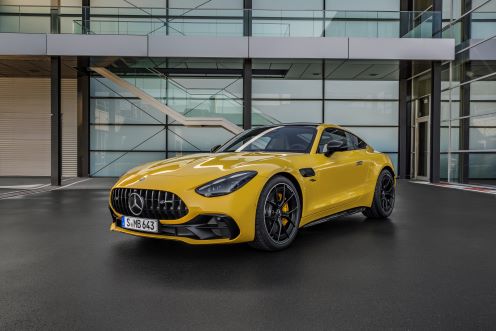
Mercedes-AMG is expanding the portfolio of the new AMG GT Coupé
London, 21 March 2024, (Oilandgaspress): – Mercedes-AMG is expanding the portfolio of the new AMG GT Coupé with the AMG GT 43 (combined energy consumption 10.3 l/100 km, combined CO₂ emissions 235 g/km, CO₂ class G)[1]. The combination of a relatively lightweight four-cylinder engine on the front axle and pure rear-wheel drive makes the new model an agile cornering artist with extremely dynamic handling and a lot of driving fun.
The AMG 2.0-litre turbo engine delivers 310 kW (421 hp) and generates a maximum torque of 500 Nm. What is special is the electric exhaust gas turbocharger, a technology from Formula 1™. This form of charging guarantees particularly spontaneous responses across the entire speed range. The new AMG GT 43 offers an even more dynamic driving experience and at the same time increased efficiency. The turbocharger is operated via the 48-volt on-board electrical system, which also feeds the belt-driven starter generator. This briefly delivers an additional boost of 10 kW (14 hp). The second generation also functions as a mild hybrid in the 48-volt on-board electrical system, which, in addition to the temporary boost in performance, also enables functions such as coasting and recuperation for even greater efficiency. The 48-volt technology also increases comfort, as the transitions between the start-stop and coasting functions are almost imperceptible.

Electric exhaust gas turbocharger improves engine response
The AMG 2.0-litre four-cylinder turbo engine in the AMG GT 43 achieves its maximum output of 310 kW (421 hp) at 6,750 rpm. The maximum torque of 500 Nm is available between 3,250 rpm and 5,000 rpm. Depending on the situation, the system also guarantees a short-term additional boost of 10 kW (14 hp) from the belt-driven starter generator (RSG).
The functional principle of the electric exhaust gas turbocharger is based on the same technology that is also used by the Mercedes-AMG Petronas F1 Team. An approximately four-centimetre narrow electric motor is integrated directly on the shaft of the turbocharger, between the turbine wheel on the exhaust side and the compressor wheel on the fresh air side. Electronically controlled, this directly drives the shaft of the turbocharger and thus accelerates the compressor wheel before the exhaust gas flow takes over the conventional drive.
This significantly improves the response behaviour right from idle speed and across the entire speed range. The combustion engine reacts even more spontaneously to accelerator pedal commands, and the overall driving experience is more dynamic. In addition, the electrification of the turbocharger enables higher torque at low speeds. This also increases agility and optimises the ability to accelerate from a standstill. Even when the driver releases the accelerator or brakes, the technology of the e-turbocharger maintains the boost pressure at all times. This ensures continuous, direct response.
Information Source: Read full article
Energy Monitors | Electric Power | Natural Gas | Oil | Climate | Renewable | Wind | Transition | LPG | Solar | Electric | Biomass | Sustainability | Oil Price |

